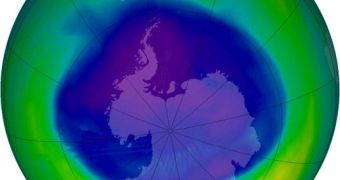The ozone's problem was signaled even from the 70s, when the United States intended to open a supersonic fleet between New York and Paris.
The researches revealed the destructive effects of the oxides resulted from combustion on the ozone layers. Few years later, researchers concluded that chlorofluorocarbons are equally harmful, used in the refrigeration installations and abandoned aerosols bottles which under the action of the sun rays, release ozone-attacking chlorine.
Other harmful gases are methane and related hydrocarbons or nitrogen oxide, which under the action of sunlight induce reactions similar to those of the chlorofluorocarbons. Even if these gases exist naturally in the atmosphere, especially the methane emitted by the ruminant mammals, termites, swamps and rice paddies, their percentage increased in connection with the number of people and industrialization process.
The results of these increases imply a certain complexity: it's not about a massive drop of the ozone levels, which do not bypass 2-3 % overall, but the effects they determine at different altitudes. The reactions triggered at 12-15 km (7.5-9 mi) from Earth continue up in the atmosphere, till almost 40 km (25 mi), where their destructive efficacy on the ozone is much higher.
This way, an ozone hole appears at 40 km over the Earth, but in the same time, in the lower layers, less than 12 km, methane and other hydrocarbons, due to the sunlight action, synthesize in compensation new ozone quantities. Due to these causes, the ozone column is deformed: it increases at 12 km altitude and rarefies at 40 km. This new structure influences the temperature and air circulation.
Moreover, these effects are not the same at all latitudes: they are amplified on the polar zones and this increases perturbation. But the hole in the ozone layer is a localized phenomenon and with a precise existence in time: it appears only in September/October over the Antarctic continent. Even if it was first detected in 1979, its influence on the ground remains weak, as the sun is low on the horizon at this latitude. And the gases that affect the ozone are hard to study, due to their instability on the atmosphere and they seem to be also implied in the greenhouse effect: they absorb the infrared radiations reflected by the Earth.
In fact, the methane is four times more efficient on doing this than the main actor of the global warming, the carbon dioxide.

 14 DAY TRIAL //
14 DAY TRIAL //